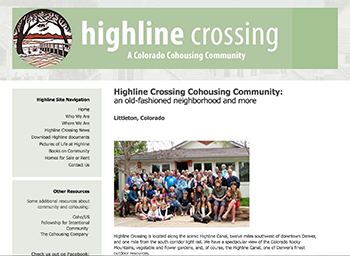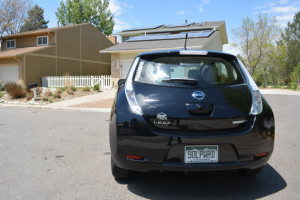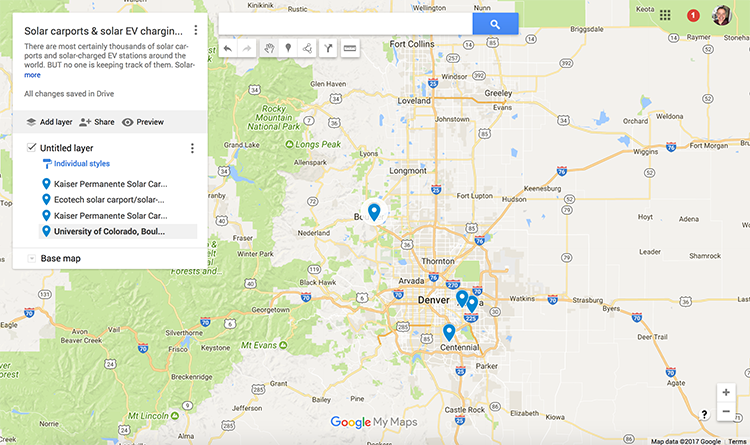![rr]()
![nissan-back]()
The Nissan LEAF has between 70 and 100 miles of range, depending on weather conditions, speed, etc.
![editors-blog-entry3]() I did not plan on having an all-electric Nissan LEAF as my ONLY car. But that’s the situation I’ve got now — and had for the past four months thanks to a marriage separation that happened in the beginning of August.
I did not plan on having an all-electric Nissan LEAF as my ONLY car. But that’s the situation I’ve got now — and had for the past four months thanks to a marriage separation that happened in the beginning of August.
(I apologize for the caps on “ONLY” — sort of. I bet 90 percent, maybe even 95 percent of LEAF owners have a second gas/EREV/PHEV car as their long-distance vehicle, meaning my situation is highly unusual. Note to Nissan: You should keep track of stats on who’s driving a LEAF as a second car, or an only car.)
My wife took our lone gas car, a 2014 Subaru Forester, with her back in August, and I have our 2014 Nissan LEAF, which I’ve been leasing since March.
No doubt, for most people, including me, having a second gas car in the household, or better yet, an EREV such as a Volt (having one BEV and one EREV, both fueled by home solar generated electricity was my dream, but not my wife’s) is a preferable situation to trying to go solely with a full electric vehicle — unless you’ve got the money for a Tesla Model S.
I’ve got two kids that need to be hauled around — a lot. Soccer practice here, choir there, German lessons here, doctor appointment over there, and, of course, mom and dad now live 10 miles apart. As a result of the separation, I’m driving more miles per day, usually 50 to 60 miles, but sometimes up to 130 miles a day (actually, this puts me in jeaporady of seriously over-running my 24,000 mile, two-year limit on my LEAF lease).
That’s the background — an impending divorce forces dad into a situation in which a BEV is his only car. Here are some thoughts/reflections about what it’s like to have an all-electric Nissan as one’s lone household car:
1. The LEAF meets 90 percent of my driving needs. EV advocates are fond of noting that a Battery Electric Vehicle (BEV) such as a Nissan LEAF with a range of about 70 (in the Colorado winter) to 100 miles (in the Colorado summer) meets the needs of most driving situations for most Americans most of the time. That’s absolutely true in my case: I’ve rarely needed to go more than the LEAF range, and/or I’ve been able to plug in to add to the LEAF’s one-time range — most of the time.
![My 2014 Nissan LEAF SV is 100 percent powered by my home's 5.59 kW solar system. nissan-front-bw]() 2. The LEAF does NOT meet 10 percent of my driving needs. Hiking and camping in the Colorado mountains is one of my favorite things to do. The LEAF simply is not equipped to get me to where I want to get, which is typically along Route 285 west of Denver. I once tried to make it to a state park (Staunton State Park) from my house in Aurora. The round trip was 85 miles. I didn’t make it. I turned around about 10 miles into the mountains when I saw that my range was plummeting while driving up what is a very steep up-mountain grade. Sadly, there is not a single EV charging station from the beginning of the foothills to Stanton State Park along Route 285, a major thoroughfare into the Colorado mountains (note to Chargepoint and other charging station companies: How about thinking about how you could place chargers to get BEVs from point A to point B, especially in the mountains, rather than seemingly placing the stations almost exclusively in sometimes rather random places in urban areas). I ended up hiking at Red Rocks Park instead, which is right at the beginning of the foothills (beginning of the mountains) here in the Denver area. But check mark against the LEAF: Does not cut it in terms of getting me to the Colorado mountains and back.
2. The LEAF does NOT meet 10 percent of my driving needs. Hiking and camping in the Colorado mountains is one of my favorite things to do. The LEAF simply is not equipped to get me to where I want to get, which is typically along Route 285 west of Denver. I once tried to make it to a state park (Staunton State Park) from my house in Aurora. The round trip was 85 miles. I didn’t make it. I turned around about 10 miles into the mountains when I saw that my range was plummeting while driving up what is a very steep up-mountain grade. Sadly, there is not a single EV charging station from the beginning of the foothills to Stanton State Park along Route 285, a major thoroughfare into the Colorado mountains (note to Chargepoint and other charging station companies: How about thinking about how you could place chargers to get BEVs from point A to point B, especially in the mountains, rather than seemingly placing the stations almost exclusively in sometimes rather random places in urban areas). I ended up hiking at Red Rocks Park instead, which is right at the beginning of the foothills (beginning of the mountains) here in the Denver area. But check mark against the LEAF: Does not cut it in terms of getting me to the Colorado mountains and back.
Yes, 70 to 100 miles of range is enough for 90 percent of driving for most people. But it’s the other 10 percent that matters — a lot. So, I don’t blame people if they make a car buying decision based on the 10 percent rather than on the 90 percent in terms of their driving needs.
3. The LEAF’s insufficient range has negatively affected my quality of life. With the LEAF as my ONLY vehicle, I cannot easily get to the mountains and back here in Colorado. Yet I love to hike, camp, etc. Yes, I could rent a vehicle, but that’s an extra cost I’m reluctant to spend given a very tight budget (that’s what happens when divorce halves your family income). It’s also inconvenient to rent a car, an extra thing to do, an extra thing to plan for. I looked into car sharing, but it’s not a practical option for a trip of 150 to 200 miles round trip. I could buy a gas clunker just for weekend trips, but, that, too, is an added expense, one I cannot really afford. Because I leased my LEAF, I cannot practically trade it in either. Even if I could, like most LEAF owners, I do NOT want to go back to gas. A Volt would have been a perfect car for me — had I known in February that my wife was going to move out in August, but of course I didn’t know. Also, my kids hated the back seat of the Volt — it’s just too small!
4. Despite EV advocates’ talk, the truth is the LEAF doesn’t cut it for quite a few (many?). Yes, 70 to 100 miles of range is enough for 90 percent of driving for most people. But it’s the other 10 percent that matters — a lot. So, I don’t blame people if they make a car buying decision based on the 10 percent rather than on the 90 percent in terms of their driving needs. In fact, the majority, probably the vast majority of LEAF (and iMiEV, and i3, and Ford Focus Electric, etc.) owners, ALSO essentially make their household car buying decisions based on this same reasoning — 10 percent of my driving needs do matter, and I gotta cover these needs because, other than possibly a Tesla Model S, a BEV isn’t going to cover those needs. Otherwise, why would so many die-hard BEV advocates have an additional gas car to back up their LEAF, iMiEV, etc.?
This all might seem ridiculously obvious, but now that I’ve experienced, first hand, what it’s like to be in a single car BEV household, I’ve come to the conclusion that some EV advocates need to lighten up some — and be a bit more specific — when arguing that BEVs work for most people. This is how the argument in favor of BEVs should be worded, every time: “A LEAF, or other BEV, will cover 90 percent of most people’s driving needs. BUT the other 10 percent still matters. Therefore, while I’m advocating you buy a BEV, you’re most likely going to need another car too.” Finally, I have to confess that it really irritates me that so many EV advocates seem to assume that everyone either has, or can can afford to have, two cars. Not true.
![A Nissan LEAF taxi in Hamburg, Germany. nissan-leaf-taxi1]() 5. Range anxiety is real — and it does matter! It sometimes seems to me that some BEV advocates are rather paternalistic, condescending, etc. in terms of the notion of range anxiety. They “pooh pooh” it, or imply it’s silly, something only “those” who don’t know anything (about electric cars) feel. Or, differently put, the BEV advocate is smarter than everyone else because he/she “gets it”: range anxiety is (allegedly) ridiculous. No, range anxiety isn’t ridiculous, it’s real, very real. Because the LEAF is my only car, I’ve had no choice other than to run it to zero bars (nearly all the way to empty) on numerous occasions. In fact, I’ve even seen the little yellow turtle pop up on the dashboard display on two nerve-wracking occasions, both in cold weather, both at night, and both with my two daughters in the car. That made me anxious, and I’ve thought I might be putting our lives in jeapordy a couple of times when I’ve had to take a left turn into our housing complex in front of three lanes of oncoming traffic speeding towards me at 60 m.p.h., turtle on the screen. Yes, range anxiety is real, and I’ve felt it several times. However I do not blame BEVs or Nissan for range anxiety.
5. Range anxiety is real — and it does matter! It sometimes seems to me that some BEV advocates are rather paternalistic, condescending, etc. in terms of the notion of range anxiety. They “pooh pooh” it, or imply it’s silly, something only “those” who don’t know anything (about electric cars) feel. Or, differently put, the BEV advocate is smarter than everyone else because he/she “gets it”: range anxiety is (allegedly) ridiculous. No, range anxiety isn’t ridiculous, it’s real, very real. Because the LEAF is my only car, I’ve had no choice other than to run it to zero bars (nearly all the way to empty) on numerous occasions. In fact, I’ve even seen the little yellow turtle pop up on the dashboard display on two nerve-wracking occasions, both in cold weather, both at night, and both with my two daughters in the car. That made me anxious, and I’ve thought I might be putting our lives in jeapordy a couple of times when I’ve had to take a left turn into our housing complex in front of three lanes of oncoming traffic speeding towards me at 60 m.p.h., turtle on the screen. Yes, range anxiety is real, and I’ve felt it several times. However I do not blame BEVs or Nissan for range anxiety.
Even though the LEAF is not entirely practical for me now that I’m at the head of a one-car, three-person family 50 percent of the time (I split custody of the kids evenly with my wife), I really love my LEAF and driving electric, and, of course, fueling my LEAF 100 percent with sunshine.
6. The LEAF doesn’t have a range problem. It might seem contradictory that after I’ve devoted a lot of space above to underscoring how the LEAF isn’t really working for me as an ONLY family car in many ways, that I would lead this last section by claiming that the LEAF doesn’t have a range problem. But, in fact, this is true. The problem is not the LEAF’s 70 to 100 mile range, the REAL problem is a lack of EV charging infrastructure. If I knew I could find a charging station at every convenience store — or, fancy this, every gas station — in America, if the grocery store, Target, my workplace, the bank, your kids’ school, public, state, and national parks, etc., all had EV charging stations — 70 to 100 miles would be good enough, at least for me. I could make it Staunton Park, for example, plug in when I got there, do a four-hour hike, and have a full charge to drive back home.
I could plug in for 20 to 60 minutes intervals while shopping. I could plug in for 120 minutes at my kids’ soccer games. I could plug in for eight hours while at work. If I could do this, I would never have a range problem. The only real problem would be long trips, say driving to Yellowstone from Denver, which is about a 700 mile trip. And even that wouldn’t be a “problem” with 20- to 30-minute quick charging stations everywhere. However, righ now there are NOT enough charging stations to do what I’m describing. Not even close, at least not here in Colorado. Yes, things could be worse than they are, and I’m grateful for the charging stations that are in place. But. There. Are. Not. Enough. Charging Stations. Period!
7. Despite drawbacks of LEAF as ONLY car, I love my LEAF. Even though the LEAF is not entirely practical for me now that I’m at the head of a one-car, three-person family 50 percent of the time (I split custody of the kids evenly with my wife), I really love my LEAF and driving electric, and, of course, fueling my LEAF 100 percent with sunshine.
![That's my Nissan LEAF parked next to a Volt. If I had known in February 2014 that in August 2014 the LEAF would be my only car, I would have leased a Volt instead. Paradoxically, I'm generally glad that I'm driving all-electric all of the time. [Photo By Christof Demont-Heinrich] myleaf-volt]() I do wish I’d leased a Volt back in February. But only in some ways — mostly when I think about not being able to get to the mountains and back in my LEAF (my wife has not proved very receptive to me switching out cars for those purposes). I’m proud of the fact that 100 percent of my 11,000 miles the past 10 months have been fully electric and that 98 percent of those miles have been powered by the 5.6 kW solar system on my home’s rooftop.
I do wish I’d leased a Volt back in February. But only in some ways — mostly when I think about not being able to get to the mountains and back in my LEAF (my wife has not proved very receptive to me switching out cars for those purposes). I’m proud of the fact that 100 percent of my 11,000 miles the past 10 months have been fully electric and that 98 percent of those miles have been powered by the 5.6 kW solar system on my home’s rooftop.
I’m definitely never going back to full gas again — EVER! (Take that Big Oil, OPEC & ISIS!)
If the rumors that the next generation LEAF will have 180 to 200 miles of true range (by true range, I mean 180 to 200 miles at 65 m.p.h. in twenty-degree weather), it’s going to be a hard decision for me to make when my two-year lease on the 2014 LEAF ends in February 2016: Get a Volt (assuming the 2017 has more backseat room), or stick with a LEAF. I do know this: If the Colorado EV charging infrastructure is sufficiently robust in February 2016 — not a sure thing at all — I would not hesitate in sticking with a LEAF with 180 to 200 miles of real-world range, even though this all-electric car, as it is now, would continue to be my household’s only car.
Related articles–>


 I want one!’
I want one!’


 2. The LEAF does NOT meet 10 percent of my driving needs. Hiking and camping in the Colorado mountains is one of my favorite things to do. The LEAF simply is not equipped to get me to where I want to get, which is typically along Route 285 west of Denver. I once tried to make it to a state park (Staunton State Park) from my house in Aurora. The round trip was 85 miles. I didn’t make it. I turned around about 10 miles into the mountains when I saw that my range was plummeting while driving up what is a very steep up-mountain grade. Sadly, there is not a single EV charging station from the beginning of the foothills to Stanton State Park along Route 285, a major thoroughfare into the Colorado mountains (note to Chargepoint and other charging station companies: How about thinking about how you could place chargers to get BEVs from point A to point B, especially in the mountains, rather than seemingly placing the stations almost exclusively in sometimes rather random places in urban areas). I ended up hiking at Red Rocks Park instead, which is right at the beginning of the foothills (beginning of the mountains) here in the Denver area. But check mark against the LEAF: Does not cut it in terms of getting me to the Colorado mountains and back.
2. The LEAF does NOT meet 10 percent of my driving needs. Hiking and camping in the Colorado mountains is one of my favorite things to do. The LEAF simply is not equipped to get me to where I want to get, which is typically along Route 285 west of Denver. I once tried to make it to a state park (Staunton State Park) from my house in Aurora. The round trip was 85 miles. I didn’t make it. I turned around about 10 miles into the mountains when I saw that my range was plummeting while driving up what is a very steep up-mountain grade. Sadly, there is not a single EV charging station from the beginning of the foothills to Stanton State Park along Route 285, a major thoroughfare into the Colorado mountains (note to Chargepoint and other charging station companies: How about thinking about how you could place chargers to get BEVs from point A to point B, especially in the mountains, rather than seemingly placing the stations almost exclusively in sometimes rather random places in urban areas). I ended up hiking at Red Rocks Park instead, which is right at the beginning of the foothills (beginning of the mountains) here in the Denver area. But check mark against the LEAF: Does not cut it in terms of getting me to the Colorado mountains and back. 5. Range anxiety is real — and it does matter! It sometimes seems to me that some BEV advocates are rather paternalistic, condescending, etc. in terms of the notion of range anxiety. They “pooh pooh” it, or imply it’s silly, something only “those” who don’t know anything (about electric cars) feel. Or, differently put, the BEV advocate is smarter than everyone else because he/she “gets it”: range anxiety is (allegedly) ridiculous. No, range anxiety isn’t ridiculous, it’s real, very real. Because the LEAF is my only car, I’ve had no choice other than to run it to zero bars (nearly all the way to empty) on numerous occasions. In fact, I’ve even seen the little yellow turtle pop up on the dashboard display on two nerve-wracking occasions, both in cold weather, both at night, and both with my two daughters in the car. That made me anxious, and I’ve thought I might be putting our lives in jeapordy a couple of times when I’ve had to take a left turn into our housing complex in front of three lanes of oncoming traffic speeding towards me at 60 m.p.h., turtle on the screen. Yes, range anxiety is real, and I’ve felt it several times. However I do not blame BEVs or Nissan for range anxiety.
5. Range anxiety is real — and it does matter! It sometimes seems to me that some BEV advocates are rather paternalistic, condescending, etc. in terms of the notion of range anxiety. They “pooh pooh” it, or imply it’s silly, something only “those” who don’t know anything (about electric cars) feel. Or, differently put, the BEV advocate is smarter than everyone else because he/she “gets it”: range anxiety is (allegedly) ridiculous. No, range anxiety isn’t ridiculous, it’s real, very real. Because the LEAF is my only car, I’ve had no choice other than to run it to zero bars (nearly all the way to empty) on numerous occasions. In fact, I’ve even seen the little yellow turtle pop up on the dashboard display on two nerve-wracking occasions, both in cold weather, both at night, and both with my two daughters in the car. That made me anxious, and I’ve thought I might be putting our lives in jeapordy a couple of times when I’ve had to take a left turn into our housing complex in front of three lanes of oncoming traffic speeding towards me at 60 m.p.h., turtle on the screen. Yes, range anxiety is real, and I’ve felt it several times. However I do not blame BEVs or Nissan for range anxiety.![That's my Nissan LEAF parked next to a Volt. If I had known in February 2014 that in August 2014 the LEAF would be my only car, I would have leased a Volt instead. Paradoxically, I'm generally glad that I'm driving all-electric all of the time. [Photo By Christof Demont-Heinrich] myleaf-volt](http://solarchargeddriving.com/wp-content/uploads/2014/12/myleaf-volt.jpg?90ba52) I do wish I’d leased a Volt back in February. But only in some ways — mostly when I think about not being able to get to the mountains and back in my LEAF (my wife has not proved very receptive to me switching out cars for those purposes). I’m proud of the fact that 100 percent of my 11,000 miles the past 10 months have been fully electric and that 98 percent of those miles have been powered by the 5.6 kW solar system on my home’s rooftop.
I do wish I’d leased a Volt back in February. But only in some ways — mostly when I think about not being able to get to the mountains and back in my LEAF (my wife has not proved very receptive to me switching out cars for those purposes). I’m proud of the fact that 100 percent of my 11,000 miles the past 10 months have been fully electric and that 98 percent of those miles have been powered by the 5.6 kW solar system on my home’s rooftop.










![This BMW i3, plugged into a charging station in Nordhausen, Germany, is the only one of its kind in that city of 50,000 says my cousin, who owns this i3. [Photo by Christof Demont-Heinrich]](http://solarchargeddriving.com/wp-content/uploads/2015/08/bmw-i3-nordhausen.jpg?90ba52)
![My daughters and I stayed at this farm in Sondershausen, Germany. As you can see, the ENTIRE roof is covered by solar panels. This is a COMMON sight in Germany. [Photo by Christof Demont-Heinrich]](http://solarchargeddriving.com/wp-content/uploads/2015/08/sondershausen-farm-solar.jpg?90ba52)





 Two Quebec companies,
Two Quebec companies, 
 It’s good to see a major solar company, in this case,
It’s good to see a major solar company, in this case, 
 This is something I saw coming way back in the summer of 2009: Electric cars and solar would create a powerful and attractive synergy with one another. That is, those with solar would be more likely to buy electric cars, and those with electric cars more likely to buy solar.
This is something I saw coming way back in the summer of 2009: Electric cars and solar would create a powerful and attractive synergy with one another. That is, those with solar would be more likely to buy electric cars, and those with electric cars more likely to buy solar.

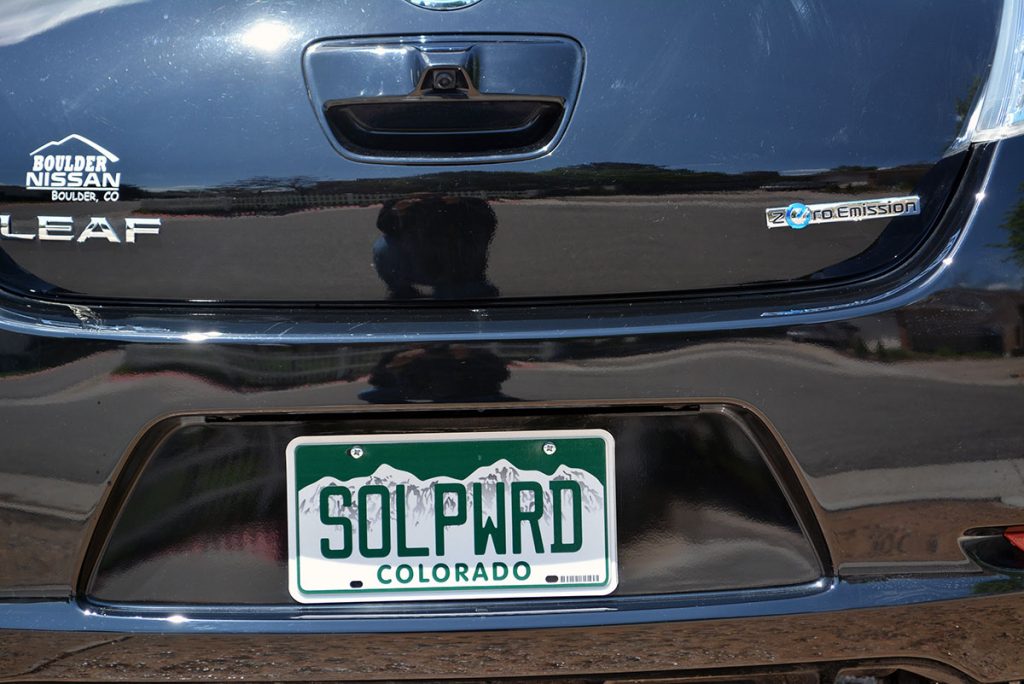
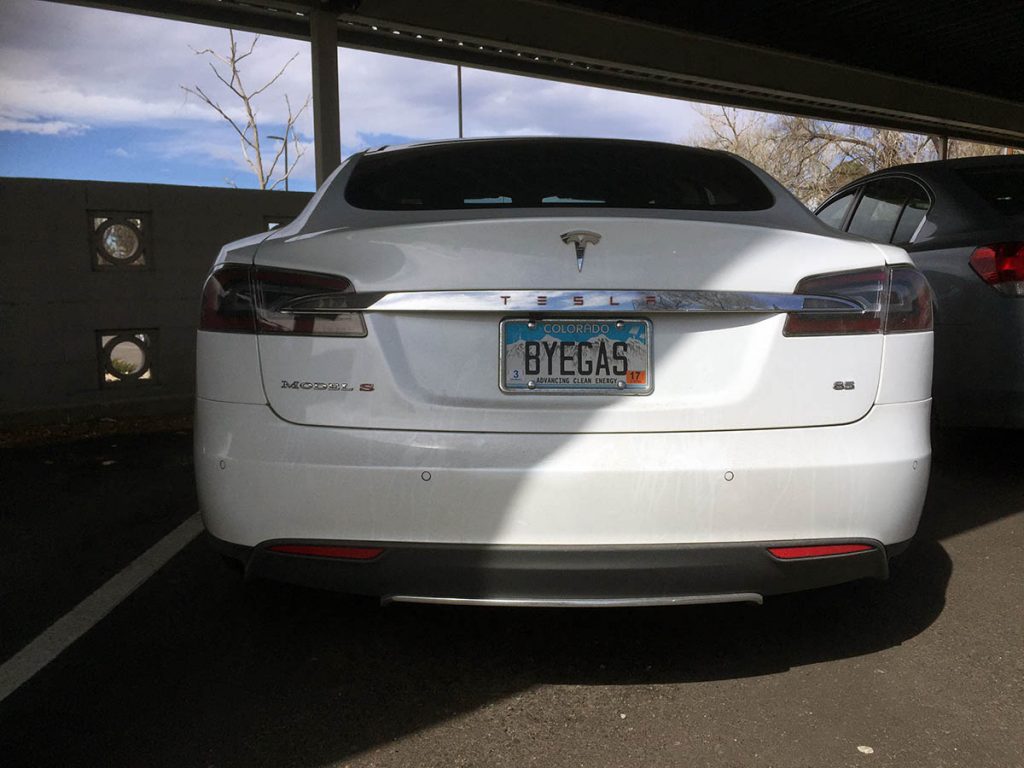

![The EV Charging & Solar Initiative provides assistance to organizations to procure affordable EV charging stations, with the option to site solar photovoltaic (PV) energy systems. [Photo Credit: EPA]](http://solarchargeddriving.com/wp-content/uploads/2017/06/EPA-solar-EV-initiative.jpg)
 I happened to be Googling a bit this afternoon and ran across this very interesting initiative:
I happened to be Googling a bit this afternoon and ran across this very interesting initiative: The amazing synergy between solar energy and electric cars hasn’t escaped the attention of a size-able number of electric car owners. In fact, according to a
The amazing synergy between solar energy and electric cars hasn’t escaped the attention of a size-able number of electric car owners. In fact, according to a 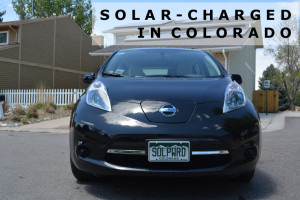 As Cleantechnica.Com puts it, “Yet again, in
As Cleantechnica.Com puts it, “Yet again, in 
